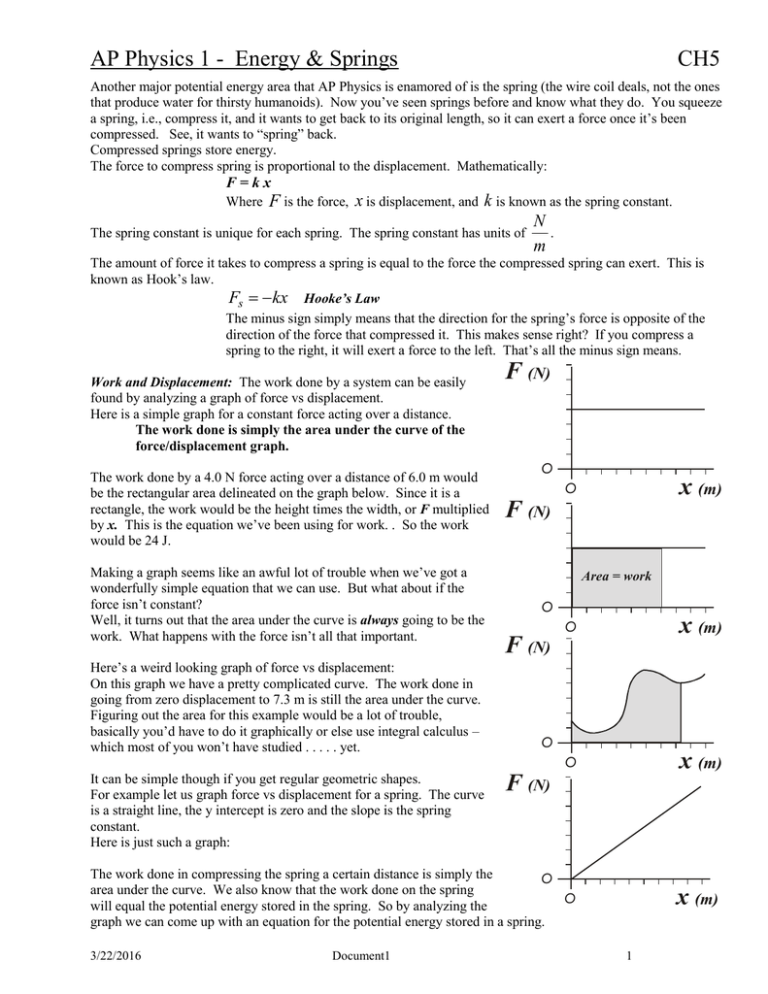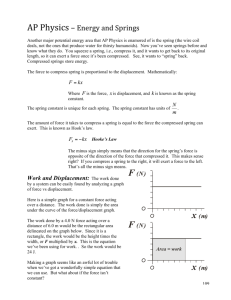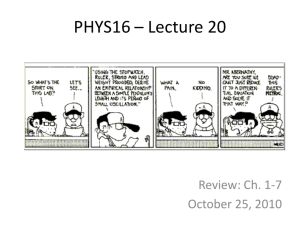AP Physics * Work and Energy
advertisement

AP Physics 1 - Energy & Springs CH5 Another major potential energy area that AP Physics is enamored of is the spring (the wire coil deals, not the ones that produce water for thirsty humanoids). Now you’ve seen springs before and know what they do. You squeeze a spring, i.e., compress it, and it wants to get back to its original length, so it can exert a force once it’s been compressed. See, it wants to “spring” back. Compressed springs store energy. The force to compress spring is proportional to the displacement. Mathematically: F=kx F is the force, x is displacement, and k is known as the spring constant. N The spring constant is unique for each spring. The spring constant has units of . m Where The amount of force it takes to compress a spring is equal to the force the compressed spring can exert. This is known as Hook’s law. Fs kx Hooke’s Law The minus sign simply means that the direction for the spring’s force is opposite of the direction of the force that compressed it. This makes sense right? If you compress a spring to the right, it will exert a force to the left. That’s all the minus sign means. Work and Displacement: The work done by a system can be easily found by analyzing a graph of force vs displacement. Here is a simple graph for a constant force acting over a distance. The work done is simply the area under the curve of the force/displacement graph. The work done by a 4.0 N force acting over a distance of 6.0 m would be the rectangular area delineated on the graph below. Since it is a rectangle, the work would be the height times the width, or F multiplied by x. This is the equation we’ve been using for work. . So the work would be 24 J. Making a graph seems like an awful lot of trouble when we’ve got a wonderfully simple equation that we can use. But what about if the force isn’t constant? Well, it turns out that the area under the curve is always going to be the work. What happens with the force isn’t all that important. Here’s a weird looking graph of force vs displacement: On this graph we have a pretty complicated curve. The work done in going from zero displacement to 7.3 m is still the area under the curve. Figuring out the area for this example would be a lot of trouble, basically you’d have to do it graphically or else use integral calculus – which most of you won’t have studied . . . . . yet. It can be simple though if you get regular geometric shapes. For example let us graph force vs displacement for a spring. The curve is a straight line, the y intercept is zero and the slope is the spring constant. Here is just such a graph: F (N) o Document1 x (m) F (N) Area = work o o x (m) o x (m) o x (m) F (N) o F (N) The work done in compressing the spring a certain distance is simply the o area under the curve. We also know that the work done on the spring will equal the potential energy stored in the spring. So by analyzing the graph we can come up with an equation for the potential energy stored in a spring. 3/22/2016 o 1 The area is a right triangle. From geometry we know that the area of such a triangle is simply: F (N) 1 A bh 2 The base of the triangle is simply x. The height is F. But the force is a function of the displacement: o F kx Plug this value for F into the area equation along with x as the base and you get: o x (m) 1 W kx 2 2 This means that the potential energy of a spring is: 1 U s kx 2 2 This equation will be available to you on the grand old AP Physics test. A spring has a constant of 125 N/m. If the spring is compressed a distance of 13 cm, what is (a) the force required to do this and (b) the potential energy stored in the spring? (a) To find the force, we use the equation for force and displacement: F kx 125 N 0.13 m m 16 N Note that we aren’t using a minus sign. This is because we know the direction of the force and a minus sign would be extra trouble. We simply can’t be bothered. (b) To find the potential energy, we use the potential energy equation for a spring: 1 N 2 U s 125 0.13 m 2 m 1.1 J We can now add the potential energy of a spring to the conservation of mechanical energy equation: K U g U s 0 K U g U s 1 1 1 1 mv02 mgy0 kx02 mv 2 mgy kx 2 2 2 2 2 This equation deals with changes in energy for: kinetic energy, gravitational potential energy, and potential energy of a spring. We can now use this to solve the odd problem or two. This is called, “applying the theory.” Sadly, it will be pretty dry – but go through it anyway, it’ll be good for you. A 0.450 kg block, resting on a frictionless surface is pushed 8.00 cm into a light spring, k = 111 N/m. It is then released. What is the velocity of the block as it just leaves the spring? We can solve this by analyzing the energy situation. There are only two terms we need worry about, the potential energy stored in the spring and the kinetic energy when the spring uncoils and the block is released. There is no initial kinetic energy and there is no final energy left in the spring. There is no change in gravitational potential energy. So we can develop the following equation: 1 2 1 2 kx mv 2 2 v 3/22/2016 1 2 1 2 kx v terms cancel out v m 2 kg m 1 m 2 111 2 0.080 m 1.26 0.450 kg s s the Document1 1 2 kx m 2 A 255 g block is traveling along a smooth surface with a velocity of 12.5 m/s. It runs head on into a spring (k = 125 N/m). How far is the spring compressed? 1 2 1 2 mv kx 2 2 xv m k 12.5 0.255 kg kg m 325 m s2 m s 0.350 m A 1.0 kg ball is launched from a spring (k = 135 N/m) that has been compressed a distance of 25 cm. The ball is launched horizontally by the spring, which is 2.0 m above the deck. (a) What is the velocity of the ball just after it leaves the spring? (b) What is the horizontal distance the ball travels before it hits? (c) What is the kinetic energy of the ball just before it hits? (a) 1 kx 2 1 mv 2 2 2 2.9 kg m 1 135 2 1.0 kg s m 0.25 m 1 y at 2 2 (b) Find the time to fall: x vt k m vx t m 0.639 s s 2y a 2 2.0 m m 9.8 2 s 2.9 m s 0.639 s 1.9 m (c) To directly calculate the kinetic energy of the ball, we would have to calculate what it’s velocity is just before it hits. This would be a complicated problem – vectors, x and y components &tc. Much easier to calculate it using conservation of energy. Its energy at the top, which will be the potential energy in the spring plus the gravitational potential energy because of the ball’s height, has to equal its kinetic energy at the bottom. We could also use its kinetic energy plus its gravitational potential energy at the top just before it leaves the table (this is because its kinetic energy must equal the potential energy stored in the spring before launch). 1 1 mgy kx 2 kx 2 0 2 0 2 1 m 1 N 2 K mgy0 kx02 1.0 kg 9.8 2 2.0 m 135 0.25 m 2 2 m s 24 J A spring is compressed a distance of 12 cm by a 675 g ball. The spring constant is 225 N/m. The ball is on a smooth surface as shown. The spring is released and sets the ball into motion. Find: (a) the speed of the ball when it leaves the spring, (b) the speed of the ball just before it leaves the edge of the table, (c) the kinetic energy of the ball just before it hits the deck, (d) the horizontal distance, x, it travels when it leaves the table until it hits the deck. Assume that the ball rolls down the ramp. 1.7 m 1.0 m x (a) 1 2 1 2 kx0 mv 2 2 (b) v x0 1 1 mv0 2 mgy0 mv 2 2 2 vf 3/22/2016 k m 0.12 m v kg m 1 225 2 0.675 kg s m 2.2 1 2 v02 gy0 2 2 1 m m 2 2.2 9.8 2 1.7 m 1.0 m 2 s s Document1 4.3 m s 3 m s 1 1 mgy0 kx02 kx 2 2 2 1 m 1 N 2 K mgy0 kx02 0.675 kg 9.8 2 1.7 m 225 0.12 m 2 2 m s (c) t x vt m 0.452 s s 2 4.3 2y a 2 1.0 m m 9.8 2 s (d) y 1 at 2 13 J 0.452 s 1.9 m A 49 kg projectile has a kinetic energy of 825 kJ when it is fired at an angle of 23.0. Find (a) the time of flight for the projectile and (b) the maximum range of the projectile. We need to know the initial velocity using its kinetic energy: 1 K mv 2 2 v 2K m 2 825 000 kg m2 49 kg s 184 2 m s m m 184 sin 23.0o 71.9 s s m m vx 0 v cos 184 cos 23.0o 169 s s v y 0 v sin (a) Find the time: (b) x vt v y v y 0 gt t m 169 15 s s m 71.9 s m 71.9 s m 9.8 2 s vy vy0 g 14.7 s 15 s 2 500 m A 25 kg box is pushed along a horizontal smooth surface with a force of 35 N for 1.5 m. It then slides into a spring (k = 1 500 N/m) and compresses it. Find the distance that the spring is compressed. kg m 1 m 1.4 2 s 25 kg s2 m m v 2 v0 2 2ax v 2ax 2 1.4 2 1.5 m 2.05 s s F m F ma a Find the acceleration: Find the final velocity : 35 Now we can find the kinetic energy of the thing: 1 K mv 2 2 1 m 25 kg 2.05 2 s 2 52.5 J We can now find the displacement of the spring using the kinetic energy we just found: 1 1 mv0 2 kx 2 2 2 3/22/2016 1 K 0 kx 2 2 x 2K0 k Document1 2 52.5 N m N 1500 m 0.26 m 4 Useless Trivia: What is the origin of the term “Catch-22”? This meaning of this term is a situation where one bureaucratic regulation is dependent on another, which in turn is dependent on the first, derives from the 1961 novel of the same name by Joseph Heller: Yossarian looked at him soberly and tried another approach. "Is Orr crazy?" "He sure is," Doc Daneeka said. "Can you ground him?" "I sure can. But first he has to ask me to. That's part of the rule." "Then why doesn't he ask you to?" "Because he's crazy," Doc Daneeka said. "He has to be crazy to keep flying combat missions after all the close calls he's had. Sure, I can ground Orr. But first he has to ask me to." "That's all he has to do to be grounded?" "That's all. Let him ask me." "And then you can ground him?" Yossarian asked. "No. Then I can't ground him." "You mean there's a catch?" "Sure there's a catch," Doc Daneeka replied. "Catch-22. Anyone who wants to get out of combat duty isn't really crazy." There was only one catch and that was Catch-22, which specified that a concern for one's own safety in the face of dangers that were real and immediate was the process of a rational mind. Orr was crazy and could be grounded. All he had to do was ask; and as soon as he did, he would no longer be crazy and would have to fly more missions. Orr would be crazy to fly more missions and sane if he didn't, but if he was sane he had to fly them. If he flew them he was crazy and didn't have to; but if he didn't want to he was sane and had to. Yossarian was moved very deeply by the absolute simplicity of this clause of Catch-22 and let out a respectful whistle. "That's some catch, that Catch-22," he observed. "It's the best there is," Doc Daneeka agreed. 3/22/2016 Document1 5





